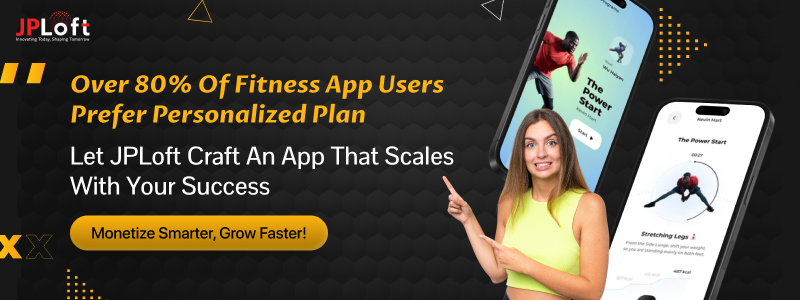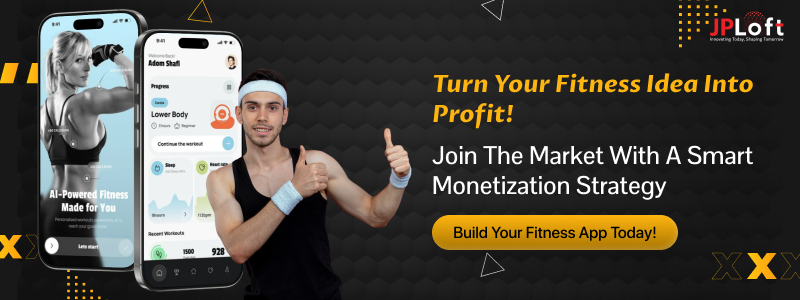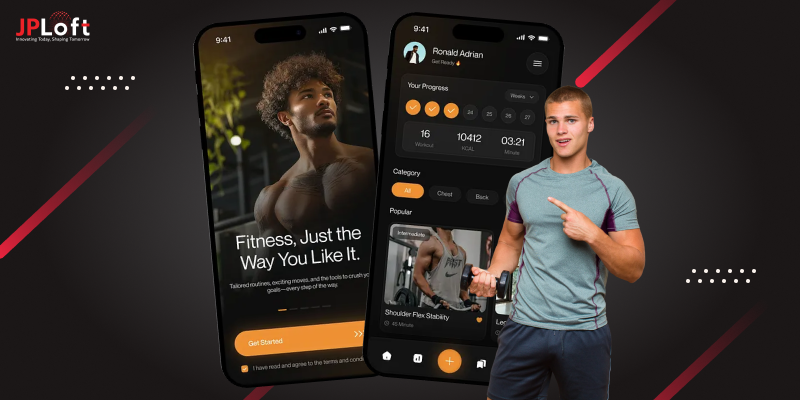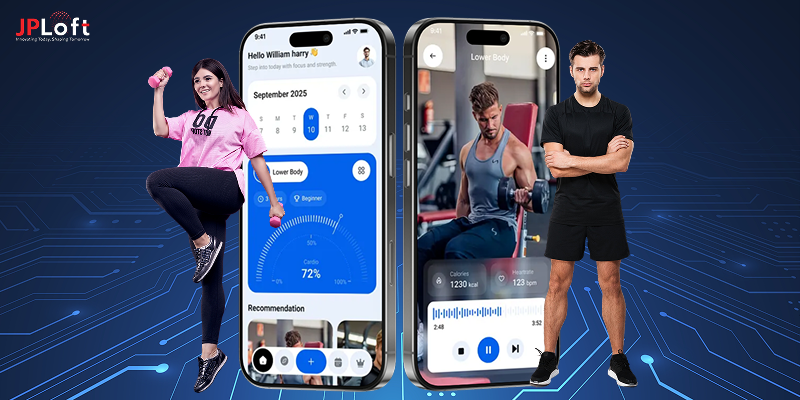Key Takeaways
The global fitness app market is estimated at USD 6.86 billion (2025) and will reach USD 25.8 billion (2030), with North America leading the market.
The most common fitness app monetization model is freemium model and subscription plans, where free users access basic features and pay for premium content.
Advertising and affiliate marketing generate additional revenue by displaying ads to free users and earning commissions from partnerships.
Many apps integrate with wearable devices, sell branded products, and offer virtual training, creating a comprehensive fitness ecosystem.
Successful fitness platforms combine multiple monetization strategies with community-building features, AI personalization, and brand partnerships.
Connect with JPLoft to transform your fitness app idea into a high-performing, scalable product with cutting-edge technology and smooth user experience.
The fitness app industry has revolutionized the way people approach wellness by integrating technology into daily routines and creating personalized fitness journeys. But behind all the features and sleek designs lies an important question: how do fitness apps make money?
With millions of active users worldwide and a rapidly growing global health consciousness, such apps are in surge demand. Fitness apps diversify their revenue streams using combinations of subscriptions, in-app purchases, advertising, affiliate links, data licensing, crowdfunding, merchandise, and on-demand services.
Understanding these fitness app monetization models and strategies helps entrepreneurs and investors explore opportunities in this booming market. It also gives users a clearer picture of the fitness app business models while powering the customer’s fitness journey.
In this blog, we will dive into the key ways these fitness apps generate revenue and thrive in this competitive market.
Fitness Apps: An Overview
Fitness apps bring convenience, personalization, and motivation to users, making it easier than ever to stay active and committed to fitness goals. From tracking daily steps to offering guided workout sessions, fitness apps cater to individuals at all levels, from beginners to professional athletes alike.
One of the biggest advantages of fitness apps is their easy accessibility. They eliminate the need for expensive gym memberships or private trainers by providing affordable, on-demand solutions at the user’s fingertips. Additionally, fitness apps often create a sense of community and accountability.
Features like progress tracking, achievement badges, and social sharing help keep users motivated. Many apps with integrated wearables give users real-time insights into their activity levels, heart rate, calories burned, and even sleep quality.
The rise of business models of fitness apps aligns with the growing global awareness about fitness and the increasing demand for digital health solutions that fit right into your palm-sized devices. The rise in the use of smartphones and wearable devices makes it easier to integrate fitness into everyday life.
► Key Features That Make Fitness Apps Popular
-
Activity Tracking: Monitor steps, calories burned, heart rate, and workouts.
-
Personalized Workout Plans: Customized routines based on goals and fitness levels.
-
Nutrition & Diet Tracking: Log meals, track macros, and maintain balanced diets.
-
Integration with Wearables: Sync with smartwatches and fitness bands for accurate data.
-
On-Demand Classes: Access to guided workouts, yoga, meditation, or strength training.
-
Community Support: Social sharing, leaderboards, and group challenges for accountability.
► Market Statistics of Fitness Apps
Here are the most important and recent statistics of how much money do fitness apps make:
-
According to FutureMarketInsights, the global fitness app market size is estimated at USD 6.86 billion in 2025 and will reach USD 25.8 billion by 2030, representing a CAGR of roughly 12.5%.
-
As estimated by Statista, in 2025, the global user penetration rate of fitness apps is 12.2%, expected to reach 13.25% by 2030.
-
Over 74% of Americans use at least one fitness app, with 60% having replaced gym memberships with app-based workouts, according to the research by AmraAndElma.
-
It has been estimated by Statista that the average revenue per user (ARPU) for fitness apps in 2025 is USD 20.79 worldwide.
-
SensorTower's research indicates that 3.6 billion fitness app downloads were made worldwide in 2024, a 6% increase from the previous year.
-
According to GrandViewResearch, North America, where the United States continues to be the single largest market for the fitness app, generated about 46.6% of global revenue in 2024.
-
Subscription-based apps report 30% higher engagement than free ones, and AI-driven personalization boosts user retention by up to 50%, found in the research by AmraAndAlma.
These figures highlight how much money fitness apps make, their surging demand, robust market value, and the evolving usage patterns that define the market in 2025 and forecast the future. Given these figures, it is evident that now is the ideal time to start an online fitness business.
Next, we explore what revenue models fitness apps use that translate this widespread adoption into sustainable revenue, uncovering the various monetization strategies that drive their success.
How do Fitness Apps Make Money?
There are various money making strategies for fitness apps that evolve alongside the digital health industry’s rapid growth and user engagement trends. The following in-depth analysis explores how to earn revenue from a fitness app and maximize profitability in today’s competitive market:
1] Freemium Model (Free + Premium Features)
As most apps are free to download, how do free fitness apps make money? They restrict advanced features behind a paywall. Users get basic services for free, like step tracking, calorie logging, or limited workouts. For personalized training, analytics, or premium workout libraries, users must subscribe or make one-time payments.
Why it works: Users get a taste of the app’s value for free, increasing the likelihood of upgrading to premium.
Revenue potential: Strong, since even a small percentage of paying users can generate significant profits when the app has millions of downloads.
2] Subscription Plans
The most common revenue generating models of fitness apps are where users pay monthly, quarterly, or annually for access to premium content. Apps provide features like unlimited workout videos, customized diet plans, progress analysis, and integration with wearables. It encourages continuous content updates and feature enhancements.
Why it works: Recurring income ensures steady cash flow and long-term sustainability.
Revenue potential: Extremely high when combined with loyalty-building features.
3] In-App Purchases
When exploring how do fitness apps make money, in-app purchases stand out as a flexible model. Fitness apps often sell digital goods like advanced workout plans, nutrition guides, or one-on-one coaching sessions. Some sell unlockable content, like exclusive yoga routines and training plans.
Why it works: Microtransactions let users pay only for what they want, without committing to a subscription.
Revenue potential: Moderate to high, depending on app popularity and content quality.
4] Affiliate Marketing and Partnerships
Fitness apps can partner with nutrition brands, fitness equipment companies, or health supplement providers. When users purchase products via links in the app, the app earns a commission. These partnerships enhance credibility and open opportunities for cross-promotions.
Why it works: Creates an additional revenue stream without directly charging users.
Revenue potential: Strong if the app has a large, health-conscious user base.
5] Advertisements
Free apps often display ads from third-party networks such as Google Ads, Facebook Ads, etc., or directly from the brands. Common ad formats include banners, interstitials, and video ads. Brands targeting health-conscious audiences pay for visibility within the app.
Why it works: Allows free apps to earn revenue without charging users directly.
Revenue potential: Moderate revenue generation, depending on user base size and engagement.
6] Selling Data and Insights (Ethical Considerations)
Data-driven insights are a significant part of how do fitness apps make money today. Fitness apps collect enormous amounts of anonymized data, such as steps, workouts, sleep cycles, diet preferences, etc. This aggregated data is valuable to research institutions, health insurance companies, and wellness brands. Transparency is crucial. Users should know how their data is being used.
Why it works: Companies pay for insights into fitness trends and consumer behavior.
Revenue potential: High, but can harm brand trust if mishandled.
7] Corporate Wellness Partnerships
Many companies now offer wellness benefits to employees to boost productivity and reduce healthcare costs. Create a fitness app that companies can use to give their employees premium or discounted access. These B2B partnerships help employees stay fit while ensuring stable and recurring bulk revenue.
Why it works: Scales revenue quickly by onboarding hundreds or thousands of users at once.
Revenue potential: Very high due to B2B contracts.
8] Integration with Wearable Devices
Build an AI app and integrate it with devices like the Apple Watch or Garmin. Some companies sell hardware and use apps to boost recurring revenue through subscriptions. It builds a loyal base of customers that continues spending across product categories.
Why it works: Creates an ecosystem where users invest in both devices and subscriptions.
Revenue potential: Very high, especially for apps backed by hardware companies.
9] Online Coaching and Virtual Training Sessions
Virtual sessions redefine how do fitness apps make money in a personalized way. Some apps provide access to certified trainers, nutritionists, or physiotherapists for one-on-one sessions. These can be paid per session or bundled into premium memberships. This model caters to users seeking expert guidance without joining a physical gym.
Why it works: Adds a human touch, increasing trust and willingness to pay.
Revenue potential: High, since personal coaching commands premium pricing.
10] E-Commerce Integration
Fitness apps expand into online stores selling branded merchandise, workout equipment, supplements, or apparel. Built-in online stores make it seamless for users to buy what they need without leaving the app. It also deepens brand engagement, as users associate the app with a complete fitness lifestyle.
Why it works: Fitness enthusiasts are natural customers for health-related products.
Revenue potential: High, especially if backed by strong branding.
11] Gamification and Paid Challenges
Create an app and integrate gamification, such as leaderboards, badges, and rewards. Some apps allow users to enter paid fitness challenges where they win prizes or rewards for completion. Fitness app money making models with paid challenges generate direct income while enhancing user motivation.
Why it works: Adds motivation and community engagement.
Revenue potential: Moderate to high, depending on user participation.
12] White Label Solutions for Gyms and Trainers
Fitness app developers license their platforms to gyms, trainers, or health startups. Businesses can rebrand and customize the app while paying licensing or subscription fees. It allows small gyms and trainers to offer digital services, expanding the reach beyond end-users to industry professionals.
Why it works: Opens a B2B revenue stream alongside consumer sales.
Revenue potential: Strong for companies targeting fitness professionals.
13] Event Hosting and Sponsorships
Fitness apps often host virtual marathons, yoga workshops, or wellness webinars. Participants pay entry fees, and brands sponsor these events for exposure. It strengthens brand reputation by associating fitness with social causes.
Why it works: Builds community while generating dual income (fees + sponsorships).
Revenue potential: Strong if the app has a large active community.
14] Tired Access for Trainers and Gyms
Some apps function as marketplaces for trainers to offer paid video sessions or fitness plans, making them one of the popular ways of how do fitness apps make money. The app earns a commission or charges subscription tiers based on trainer access. One of the popular dual-sided revenue generating models of fitness apps, increasing revenue diversity and app engagement.
Why it works: It monetizes both parties. Trainers earn income while apps take a cut.
Revenue potential: Strong in urban areas with high demand for professional trainers.
15] Integration with Healthcare and Insurance
Insurance companies often reward customers for maintaining fitness goals. Fitness apps can integrate with insurers to track health metrics, giving users discounts or benefits. It creates strong institutional partnerships that provide steady, large-scale revenue.
Why it works: Creates a win-win situation for everyone. Users save money, insurers reduce risk, and apps earn integration fees.
Revenue potential: High, especially in markets with advanced health-tech adoption.
As users demand increasingly personalized and interactive experiences, successful apps will continue to evolve their fitness app monetization strategies to balance user value with sustainable profitability.Hiring an experienced mobile app development company in Denver can help integrate these models seamlessly.
The following case studies highlight how successful fitness app business models have tailored their approaches to maximize user value and profitability.
Case Studies of Successful Fitness Apps Monetization Models
Successful fitness app monetization strategies distinguish themselves from other apps by their ability to convert user engagement into sustainable revenue while adding value to their lives. Let’s explore real-world cases of top fitness apps of how they monetize their platforms effectively while retaining millions of loyal users.
1. MyFitnessPal – The Power of the Freemium + Subscription Model
MyFitnessPal, launched in 2005, has become one of the most popular fitness and nutrition tracking apps globally. It offers users the ability to log food, monitor calories, and track their fitness progress.
Monetization Strategy: Freemium Mode + Premium Subscription (MyFitnessPal Premium) + Ad Revenue + Partnership
Why It Works:
The app effectively hooks users through free essential tools, then encourages upgrades through data-driven insights and convenience. Its large food database (over 14 million items) keeps users engaged daily.
Results:
-
Over 200 million registered users.
-
Estimated annual revenue exceeding USD 120 million, primarily from subscriptions, which paid off the cost to develop an app like MyFitnessPal.
-
High retention due to strong integration with wearables and other fitness ecosystems.
Lesson:
The freemium + subscription hybrid remains one of the best fitness app revenue models with broad user bases and high sustainability.
2. Strava – Turning Social Fitness into Subscription Success
Strava, founded in 2009, has transformed fitness tracking into a social network for athletes. This app is not just about running or cycling, but it is also about community and competition.
Monetization Strategy: Freemium Model + Subscription (Strava Premium) + Sponsored Challenges + Merchandise & Affiliate Sales
Why It Works:
Strava capitalizes on social engagement. Users are motivated by competition, sharing progress, and community recognition. The psychological pull of comparison and belonging keeps people active and subscribing.
Results:
-
Over 120 million users worldwide (as of 2024).
-
Around a 10% conversion rate to paid subscriptions, a remarkable number in the fitness space.
-
Consistent growth even after tightening free features in 2020.
Lesson:
Creating a community-driven ecosystem adds emotional value beyond workouts, translating directly into long-term revenue.
3. Fitbit – Blending Hardware Sales with Premium Digital Subscriptions
Fitbit is a pioneer in wearable fitness technology, offering smartwatches and trackers that monitor activity, sleep, and heart rate. Its success lies in combining hardware sales with recurring digital subscriptions.
Monetization Strategy: Hardware Sales + Fitbit Premium Subscription + Corporate Wellness Programs + Data Partnerships
Why It Works:
The integration of hardware and software ensures user loyalty. People who invest in Fitbit devices naturally subscribe to Premium to unlock their full potential.
Results:
-
Over 31 million active users.
-
Fitbit Premium contributes significantly to recurring revenue, helping offset seasonal device sales fluctuations.
-
Acquisition by Google (2021) strengthened its ecosystem and analytics capabilities.
Lesson:
The hardware + software synergy business models of fitness apps create an ecosystem that maximizes customer lifetime value (CLV). Partnering with an experienced AI app development company can help integrate them smoothly.
4. Peloton – Combining Subscriptions, Hardware, and Community
Peloton revolutionized at-home fitness by blending technology, media, and hardware. It’s known for high-quality stationary bikes and treadmills integrated with live and on-demand workout classes.
Monetization Strategy: Hardware Sales + Digital Subscription + App Subscription + Branded Apparel (Peloton Apparel)
Why It Works:
Peloton sells an aspirational lifestyle, not just workouts. Its live classes, motivational trainers, and strong brand identity encourage community loyalty.
Results:
-
Over 6.5 million members globally.
-
Subscription revenue surpassed hardware sales in recent years, proving the power of recurring income.
-
Peloton’s churn rate is among the lowest in the subscription industry.
Lesson:
Building a brand-driven experience that combines physical and digital engagement drives exceptional retention and monetization.
5. Nike Training Club (NTC) – Free Access, Strategic Brand Monetization
Nike Training Club is one of the most popular free workout apps, offering hundreds of on-demand workouts. Unlike others, NTC doesn’t rely directly on subscriptions.
Monetization Strategy: Free Access + E-Commerce Integration + Events and Challenges + Partnerships
Why It Works:
Instead of direct revenue, Nike uses NTC as a brand funnel that encourages users to buy physical products from its store. It’s an indirect monetization strategy focused on lifetime customer value.
Results:
-
Over 50 million downloads globally.
-
Increased online product sales and brand loyalty.
-
Significant engagement spikes occurred during the pandemic when premium content was made free.
Lesson:
Sometimes, the top fitness app monetization strategies indirectly use value-driven apps to strengthen product sales and brand loyalty.
6. Calm – Subscription Success through Wellness and Mindfulness
Calm is a leading wellness app that focuses on meditation, sleep, and relaxation. It capitalizes on fitness app monetization models that surround best with the growing mental health and mindfulness initiative.
Monetization Strategy: Subscription Model + Corporate Partnerships + Content Collaborations
Why It Works:
Calm differentiates itself through emotional connection and quality content rather than hardcore fitness tracking. Its recurring subscriptions align perfectly with wellness routines.
Results:
-
Over 150 million downloads and millions of paying subscribers.
-
Estimated annual revenue of over USD 200 million.
-
A strong foothold in corporate wellness programs globally.
Lesson:
In the wellness space, emotional value and premium content can be just as profitable as performance tracking.
7. Freeletics – AI-Powered Personalization for Profit
Freeletics focuses on bodyweight training and personalized fitness programs. It uses AI to tailor workouts based on user goals and performance.
Monetization Strategy: Freemium + Subscription Model + AI Coaching + Affiliate Partnerships
Why It Works:
The AI-powered approach delivers a personalized experience at scale that gives users the feeling of a real coach without high costs.
Results:
-
Over 50 million users in 160 countries.
-
Annual revenue growth driven by paid AI coaching plans.
-
Recognized as one of Europe’s top digital fitness companies.
Lesson:
AI personalization is one of the powerful tools for fitness app monetization models that makes digital coaching scalable and profitable.
8. Headspace – Blending Subscriptions and Corporate Wellness
Headspace is another leader in the mindfulness and meditation space, focusing on mental fitness. Makes meditation accessible, promoting better focus, reduced stress, and overall emotional well-being.
Monetization Strategy: Subscription Model + Headspace for Work + Content Licensing
Why It Works:
Headspace smartly diversified into B2B wellness while maintaining a strong consumer base. Its relatable, friendly interface attracts both individuals and enterprises.
Results:
-
Over 70 million users worldwide.
-
Strong recurring revenue from both consumer and corporate channels.
-
Easily paid off the cost to create an app like Headscape.
-
Partnerships with global companies like Google and Starbucks.
Lesson:
Combining B2C and B2B fitness apps business models ensures financial stability and broader market penetration.
Successful fitness app money making models go beyond being just a revenue stream. They build ecosystems, experiences, and emotional connections. Whether through data-driven personalization, brand communities, or hybrid monetization, the common thread is value. When users feel seen, supported, and motivated, they willingly invest, making fitness apps one of the most lucrative categories in the digital economy.
Scale Smarter: Build Your Fitness App with JPLoft
In a world where fitness is going digital, your app idea deserves a technology partner that understands innovation, performance, and scalability. JPLoft, a fitness app development company, empowers businesses to build high-performing fitness apps that engage, retain, and inspire users.
Whether you’re creating a personalized workout tracker, a yoga and meditation app, or a complete fitness community platform, JPLoft delivers tailor-made solutions to turn your vision into reality. Our team of expert developers, designers, and strategists combines intuitive UI/UX, cutting-edge technology, and AI-powered personalization to help your app stand out in a competitive market.
From wearable integrations and real-time analytics to secure payment systems and social engagement features, we craft seamless digital experiences that drive long-term success. With JPLoft, you don’t just build an app, you build a brand. Our end-to-end development services ensure faster time-to-market, better scalability, and a superior user experience that keeps users motivated.
Partner with JPLoft and scale smarter because your app deserves seamless integration of the best business models of fitness apps and nothing less than excellence.
Conclusion
The success of modern fitness apps lies not only in their innovative features but also in how to monetize a fitness app. As digital fitness continues to grow, the next generation of apps will likely focus on even deeper personalization, integration with wearable technology, and holistic wellness experiences.
What truly sets them apart is their ability to build trust, create communities, and deliver consistent results that keep users engaged long term. From freemium and subscription models to partnerships, ecommerce, and AI-driven personalization, the top fitness app monetization strategies find the perfect balance between value and profitability.
The key to enduring success will always be the same, providing genuine value while adapting to evolving user needs. By combining data, creativity, and customer-centric innovation, fitness apps can continue to transform lives while thriving in an increasingly competitive digital landscape.
FAQs
Fitness apps make money through various models like subscriptions, freemium upgrades, in-app purchases, advertisements, affiliate marketing, and corporate wellness partnerships. They also earn by integrating with wearables, offering premium content, and selling personalized training or nutrition plans to users.
The subscription model is considered the most profitable. It provides predictable recurring income while allowing developers to continuously update content and features, keeping users engaged long term.
Corporate wellness programs allow fitness apps to partner with organizations that offer health benefits to employees. This creates a large-scale, steady revenue source while promoting brand visibility.
Most fitness apps follow a freemium model, where the app is free to use but offers premium features through paid subscriptions or in-app purchases. Free users help grow the app’s audience, while paid upgrades generate consistent revenue.
They maintain profitability by diversifying revenue streams like combining subscriptions, in-app purchases, affiliate marketing, and partnerships. Additionally, they focus on user retention through personalization, community engagement, and continuous innovation.













Share this blog